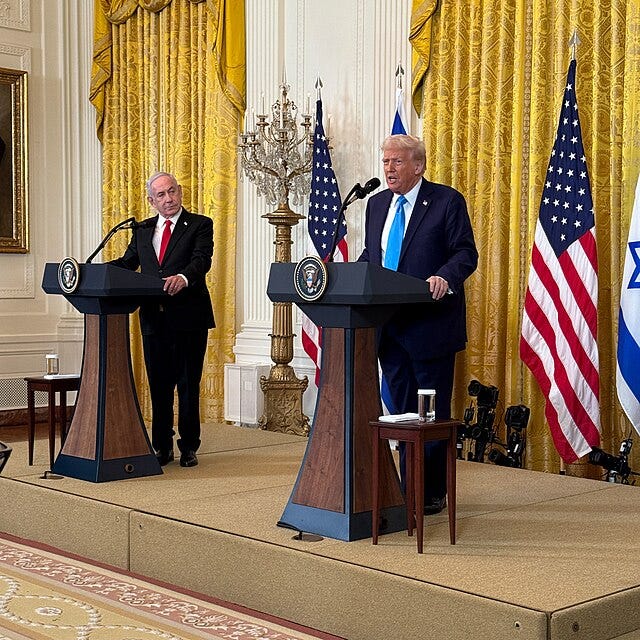Issue 81: The Art of the Deal
For better or worse, Trump casts a giant shadow over the Israel-Hamas ceasefire agreement

“The worst thing you can possibly do in a deal is seem desperate to make it. That makes the other guy smell blood, and then you’re dead. The best thing you can do is deal from strength, and leverage is the biggest strength you can have. Leverage is having something the other guy wants. Or better yet, needs. Or best of all, simply can’t do without. Unfortunately, that isn’t always the case, which is why leverage often requires imagination, and salesmanship. In other words, you have to convince the other guy it’s in his interest to make the deal.”
Over the last few weeks I decided to read Trump: The Art of the Deal in the hopes of better understanding the mentality of the new/old US president. It is a shame I hadn’t back in 2016. While many elements of the book are generic business advice and personal grandstanding, I did find passages that forced me to think again about his first presidency and examine in greater detail the early days of his return to the White House.
The timing of my reading was particularly important because Trump is credited with being the leverage that enabled a ceasefire agreement to be reached between Hamas and Israel. This agreement - which includes the first release of Israeli hostages since November 2023 in exchange for the release of Palestinian prisoners, a gradual Israeli military withdrawal from the Gaza Strip, and the return of internally displaced Palestinians in Gaza - is broken into multiple phases and stages usually centered around the the release of hostages and prisoners. Israeli society has since been riding an emotional rollercoaster that coincides with each hostage release, and the national discourse on the merits of the deal and future prospects have mirrored those emotional swings.
Trump’s arrival isn’t the only factor that convinced Israel and Hamas to agree to terms that the mediators and the Biden administration secured in May 2024. Israel’s campaign against Hezbollah, the elimination of senior Hamas figures Ismail Haniyeh and Yahya Sinwar, and the collapse of the Assad regime in Syria all contributed to isolating Hamas leadership and bringing it to the negotiating table as well as convincing an emboldened Netanyahu to (temporarily) pause the war. The IDF’s consistent message that it would not be able to secure the majority of hostages by military force or covert operation also played a role in Israel’s calculus.
But there is no doubt that Trump - whose unorthodox style could keep the parties in line or blow the entire thing up - casts a giant shadow over the agreement’s future. While Israel and Hamas may have their own reasons for wanting the agreement to derail prior to its completion, it feels like the agreement’s fortunes are dependent on why Trump wanted a ceasefire in the first place, and whether his personal interest in maintaining the deal remain steadfast in the coming weeks.
A final note: I’ve been asked recently whether I think the deal is “good” or “bad”. In my opinion these terms are as unsuitable for assessing the situation as the terms “winner” and “loser” that I often see employed. Civilians are always the losers during times of war, the only question is the degree of loss. States and non-state actors will present themselves as “winners” or “losers/victims” based on what suits their interests. So assessing the merit of a deal that for both Israelis and Palestinians a) saves human lives and b) reunites families cannot be considered “bad”. The “good” of the deal, however, can be debated and this is why moral arguments require a flexible and diverse vocabulary that can bear the weight of complexity and disagreement. Which is to say, I am deeply grateful that so many families have been reunited and that human lives have been saved. I hope the weeks and months ahead prove the merit of the agreement and provide a pathway for addressing the many urgent issues associated with the conflict.
In theme with this week’s newsletter, I am promoting two pieces I published on different platforms:
The first is an article on Trump’s potential support of the India-Middle East-Europe Economic Corridor (IMEC) which I wrote for War on the Rocks in late January. In my mind, IMEC has the potential to be one of the most consequential economic and geopolitical projects in the coming decade, and I detail how I think the Trump administration should encourage its development.
It is always a good feeling when you manage to get out in front of a story, and Trump’s recent press conference with Indian prime minister Narendra Modi reinforced many of positions I presented in the article:
The second piece addresses Trump’s controversial statements on Gaza, which I authored for the German Marshall Fund (where I recently accepted a visiting fellow position in addition to my other professional commitments). The main thrust of the piece is a simple and important message for the international community: assume that Trump means what he says. If the same guy who thinks “skyscrapers are machines for making money” says he wants to “own Gaza” and oversee its transformation, your time is better spent creating a feasible alternative than listing the ways it isn’t possible.
Thanks for taking the time to read. As always, I welcome your comments and questions.
Best,
Gabi




Excellent summary position .. In terms of regional politics / geo politics .. the region with Lebanon, Syria, Israel and Iran looks very different today, to pre October 7 2023. I only hope the IDF maintains its achievements and superiority, whilst the internal strife within Israeli politics and population become far less fractured and destructive.